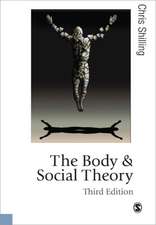Embodiment and Mechanisation: Reciprocal Understandings of Body and Machine from the Renaissance to the Present
Autor Daniel Blacken Limba Engleză Hardback – mai 2014
| Toate formatele și edițiile | Preț | Express |
|---|---|---|
| Paperback (1) | 464.79 lei 6-8 săpt. | |
| Taylor & Francis – 25 noi 2016 | 464.79 lei 6-8 săpt. | |
| Hardback (1) | 1223.42 lei 6-8 săpt. | |
| Taylor & Francis – mai 2014 | 1223.42 lei 6-8 săpt. |
Preț: 1223.42 lei
Preț vechi: 1287.80 lei
-5% Nou
Puncte Express: 1835
Preț estimativ în valută:
234.10€ • 245.08$ • 193.70£
234.10€ • 245.08$ • 193.70£
Carte tipărită la comandă
Livrare economică 05-19 aprilie
Preluare comenzi: 021 569.72.76
Specificații
ISBN-13: 9781472415431
ISBN-10: 1472415434
Pagini: 220
Dimensiuni: 156 x 234 x 14 mm
Greutate: 0.49 kg
Ediția:Revised.
Editura: Taylor & Francis
Colecția Routledge
Locul publicării:Oxford, United Kingdom
ISBN-10: 1472415434
Pagini: 220
Dimensiuni: 156 x 234 x 14 mm
Greutate: 0.49 kg
Ediția:Revised.
Editura: Taylor & Francis
Colecția Routledge
Locul publicării:Oxford, United Kingdom
Notă biografică
Daniel Black is Lecturer in Communications and Media Studies at Monash University, Australia and co-editor of Complicated Currents: Media Flows, Soft Power and East Asia. He has published numerous book chapters and articles investigating our embodied relationship with technology, including publication in journals such as Body & Society and Theory, Culture & Society.
Recenzii
’Embodiment and Mechanisation is an exciting and impressive exploration of the matter of mechanistic thought, and one that makes a profound contribution to contemporary theories of embodiment and the intellectual histories that shape them. Black’s analysis of the complex and shifting body-machine relationship is insightful, richly variegated, and precise in its execution. From dissection to information processing, automata to robotics, steam engines to artificial intelligence, Embodiment and Mechanisation is a veritable tour de force. Try as I might, I couldn’t put it down.’ Nikki Sullivan, Macquarie University, Australia
Cuprins
Introduction; Chapter 1 How to Look at Bodies; Chapter 2 Machina Carnis; Chapter 3 Android Dreams; Chapter 4 Informateriality; Chapter 5 An Aesthetics of the Invisible; Conclusion;
Descriere
This book explores the interaction between mechanistic beliefs about human bodies and the successive technologies that have established and illustrated these beliefs. Drawing upon newer perspectives on technology and embodied human thought it provides a position from which widely held assumptions about our relationship with technology can be understood and questioned, by both showing how these presuppositions have emerged and developed, and examining the extent to which they are dependent upon our grasp of specific technologies.















